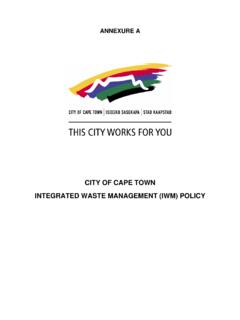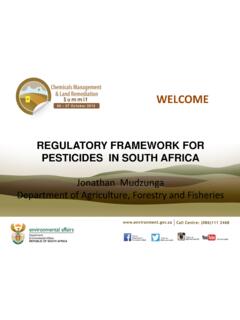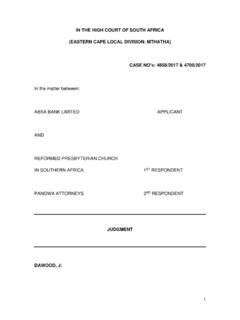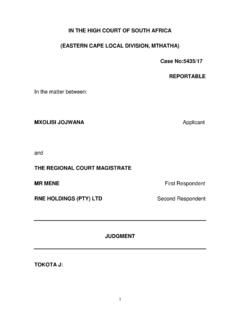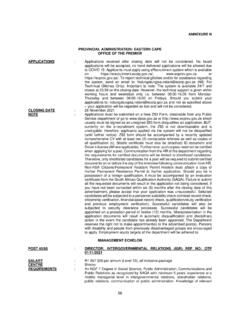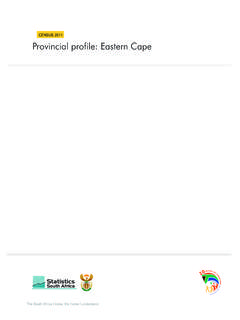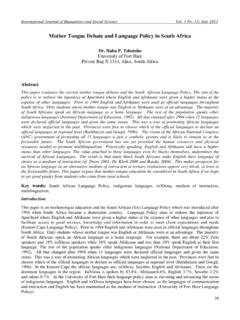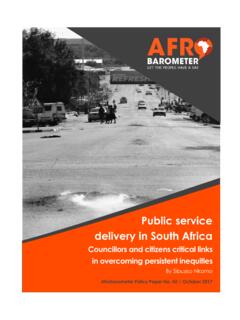Transcription of South Africa State of Waste Report
1 South Africa State of Waste Report First draft Report South Africa State OF Waste Draft Zero Reportii South Africa State of Waste Report First draft Report South Africa State OF Waste Draft Zero Reportiii South Africa State of Waste . A Report on the State of the Waste . First draft Report First published in 2018 Department of Environmental Affairs ISBN XXX-X-XXX-XXXXX-X This document may be reproduced in whole or in part for educational or non-profit purposes without special permission from the copyright holder, provided that acknowledgement of the source is made. No use of this publication may be made for resale or for any other commercial purpose whatsoever without prior written permission from the Department of Environmental Affairs. Citation of the Report Department of Environmental Affairs. 2018. South Africa State of Waste . A Report on the State of the environment. First draft Report . Department of Environmental Affairs, Pretoria.
2 XX pp. Publication This publication is available on the website of the Department of Environmental Affairs at and The Report is also available on DVD. A charge may be made according to the pricing policy which can be seen on the website. This publication is available at the following libraries: The Constitutional Court of South Africa (Legal Section of Library); Library of Parliament (Legal Deposit Section); Central Reference Library in eThekwini Municipality; National Library of South Africa Pretoria Campus (NLSA-Pta); National Library of South Africa cape Town Campus (NLSA-CT); South African Library for the Blind in the Eastern cape ; and the South African Provincial Libraries including Eastern cape (King Williams Town), Free State (Bloemfontein), Gauteng (Johannesburg), KwaZulu-Natal (Pietermaritzburg), Limpopo (Polokwane), Mpumalanga (Nelspruit), North West (Mmabatho), Northern cape (Kimberley) and Western cape ( cape Town) For further information, please contact: Department of Environmental Affairs Private Bag X447 Pretoria 0001 Republic of South Africa Web site: and Disclaimer: This Report is based on papers produced by expert groups and other additional information gathered by the project team.
3 The views it contains are not necessarily those of Government. The Department of Environmental Affairs and other agencies do not accept responsibility in respect of any information or advice given in relation to or as a consequence of anything contained herein. Every effort has been made to contact and acknowledge copyright holders. However, should any infringement have inadvertently occurred, the Department of environmental Affairs wishes to be notified. We take this opportunity to offer our apologies. In the event of a reprint, any errors will be corrected. For a listing of errors or omissions in this Report found subsequent to printing, please visit our website at and Printed and bound in South Africa by XXXXXXXXXXXX on behalf of the Government Printer. Team for preparation of the South Africa State of Waste First Draft Report Project Manager: Mr Anbendren Pillay Contributing writers: Ms Natalie Kohler, Mr Michael Van Niekerk, Ms Dikae Manchidi, Ms Lufuno Nemakhavhani (Golder Associates Africa ) and Ms Sharon Meyer, Ms Gabriele Steyn, and Ms Rozanne Els (Savannah Environmental) Copy editing: Golder Associates Africa Quality review and proof reading: Mr Anbendren Pillay, Ms Senisha Soobramany, Mr Donald Sehaswana, and Mr Jeremia Sibande (Department of Environmental Affairs) and the CSIR Cover and layout design: Mr Brian Chapole (Department of Environmental Affairs) and Mr Tiaan Van Niekerk (Golder Associates Africa ) Photo credits: Creative commons, Golder Associates Africa and Department of Environmental Affairs Communications.
4 Department of Environmental Affairs South Africa State OF Waste Draft Zero Reportiv Executive Summary This first South African State of Waste Report (SoWR) provides snapshot of the State of Waste generation and management in South Africa , the key driving forces and pressures, and how South Africa is performing in terms of short and medium terms responses to contemporary changes in the Waste sector. The SoWR differs slightly from its predecessor, the 3rd National Baseline Report (2012), in that it not only presents the quantities of the different Waste types generated, but also looks at the drivers and pressures of the State of Waste in South Africa , the current management of Waste , the resulting impacts, and short and medium term actions or responses to identified drivers, pressures and impacts. It is therefore similar in structure to the 2nd South Africa Environment Outlook (SAEO). The main Report consists of the following five chapters: Chapter 1: Introduction This chapter provides an introduction to the Report .
5 It briefly discusses the purpose of a SoWR in terms communicating credible, timely and accessible information about Waste generation and level of compliance of Waste infrastructure to decision makers and society. It highlights the value of understanding not only the quantities of Waste generated, but also its management now and in the immediate future. Further to this, the importance of monitoring the State of Waste on an ongoing basis and at defined intervals. The chapter briefly introduces Drivers Pressures State Impact Response (DPSIR) reporting framework developed by the European Environment Agency (EEA), and on which this SoWR is largely structured. In terms of this framework, the current or future State (S) is the result of specific drivers (D) and pressures (P), positive or negative, which impact (I) on human health and the environment. The responses (R) represent the solutions ( policies, investments) for what should then be done to improve or maintain the desired State (S) Importantly, the chapter also outlines the assumptions and limitations in compiling this 1st SoWR.
6 Chapter 2: Drivers and Pressures This chapter provides a brief overview of the drivers and resulting pressures directly affecting the generation and management of Waste in South Africa . This includes population growth, economic growth, income, level of urbanisation and the globalisation of the recyclables market. According to Stats SA, it was established that while South Africa s population is growing on a year on year basis (from 53 million in 2013 to million in 2017), that the annual population growth has been declining (from in 2013 to in 2017). This is important given the linkages between Waste generation and population size and growth. It was also established that the South African economy, measured in terms of Gross Domestic Product (GDP), has also been growing year on year from R trillion in 2013 to R trillion in 2017. This is important given that economic growth is the driving force for several Waste generating economic sectors, such as construction.
7 Given the strong correlation between income level and standard of living, the consumption of goods and services, and the amount of Waste generated, the income of individuals and South African households was also considered. According to Stats SA, it was established that the majority of individuals (91%) are from low income households, while only and of individuals are from middle income and high income households respectively. Solid Waste is generally considered to be an urban issue as Waste generation rates tend to be much higher in urban areas. It was found that South Africa , like most developing countries, is experiencing continuing urbanisation with the proportion of the South African population living in urban areas expected to increase to approximately by 2030 and 80% by 2050. The chapter provided a brief overview of the globalisation of the recycling market, and in South Africa State OF Waste Draft Zero Reportv particular the trade in recovered plastic, paper, scrap metal and Waste Electrical and Electronic Equipment (WEEE).
8 Chapter 3: State This chapter provides a brief overview of the State of Waste in South Africa , including the main types and quantities of Waste generated, and the level of compliance of Waste management infrastructure. Waste Types The chapter starts by defining what is meant by Waste , and the definition of general Waste and hazardous Waste . Waste Generation Taking cognisance of the driving forces and pressures, it is estimated that in 2017 South Africa generated 42 million tonnes of general Waste in 2017. It is estimated that only million tonnes (11%) of general Waste was recycled during this period. However, taking into account only the mainstream recyclables, namely paper, plastics, glass and metals, the recycling rate is estimated to be 34%. These calculated tonnages of general and hazardous Waste generated are based on information collected from a range of sources and a different methodology to the 3rd National Baseline Report (2012) as more information/studies are known to us now and Waste regulations have changed in recent years.
9 The largest contribution to total quantity of general Waste was other (35%), which comprises predominantly biomass from the sugar mills, sawmills, and paper and pulp industry. This is followed by organic Waste (16%), construction and demolition Waste (13%), scrap metals (8%), and commercial and industrial Waste (7%). Since the 3rd National Baseline Report (2012), there have been numerous Waste characterisations studies in some of the major metropolitans. In 2017, South Africa generated approximately 38 million tonnes of hazardous Waste , with only about 7% of hazardous Waste generated re used or recycled. The remainder was treated and/or landfilled. The majority of the hazardous Waste that was generated was mineral Waste , fly ash and dust and bottom ash, mainly from coal fired power stations ( ). One of the challenges noted in the previous 3rd National Baseline Report (2012), is that particular Waste types, namely brine, slag, WEEE and sewage sludge, appear on both general and hazardous Waste lists.
10 As a result, the estimated quantities of these unclassified wastes ( million tonnes) are presented separately from the general and hazardous Waste streams so as to prevent skewed data. This is also in part due to the promulgation of the Waste Classification and Management Regulations of August 2013 which have resulted in less unclassified wastes and resulting in a significant decrease in Waste quantities. Waste Imports and Exports In 2017, an estimated 137,490 tonnes of general Waste , mainly paper, plastic, glass and metals, was imported, while an estimated 258,557 tonnes of general Waste , mainly paper, plastics and metals was exported (SARS). South Africa also imports and exports hazardous wastes. This trade is regulated by the Basel Convention. Waste Collection Services The rendering of a regular Waste collection service is the responsibility of the municipality. In 2016, approximately 59% of households had their Waste collected by the local authority, service provider or a community member, while 2% of households had their Waste collected from a communal container or central collection point.
